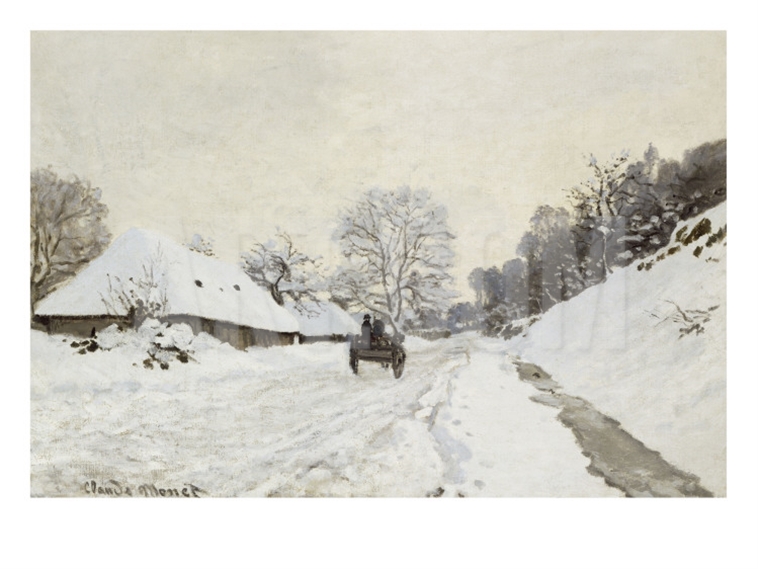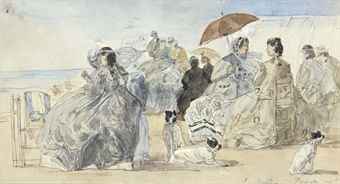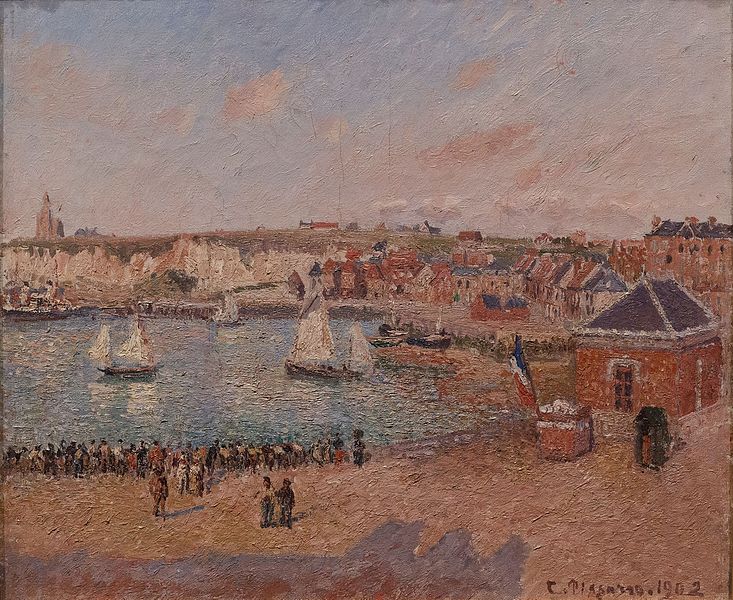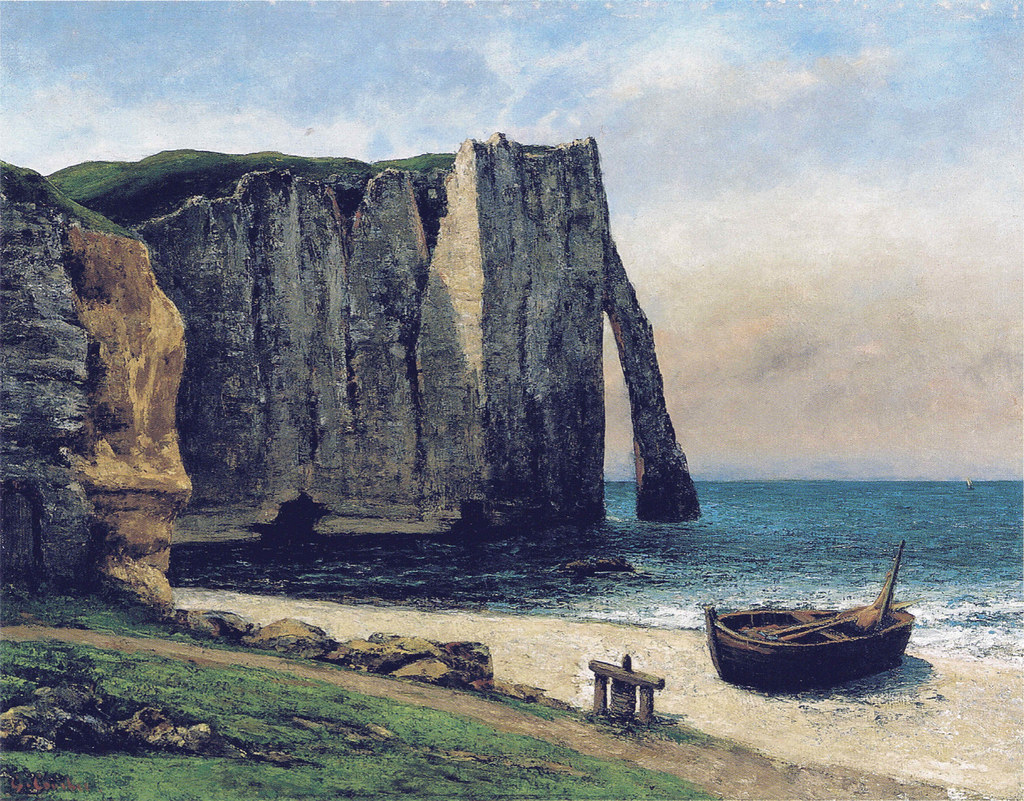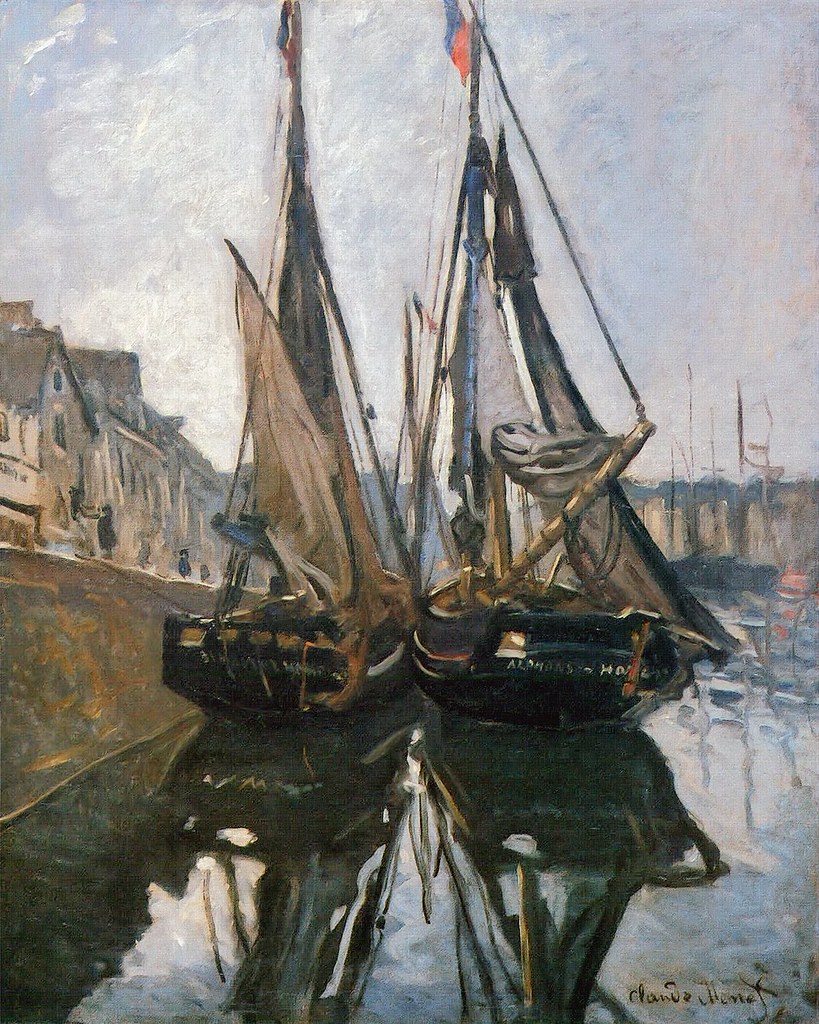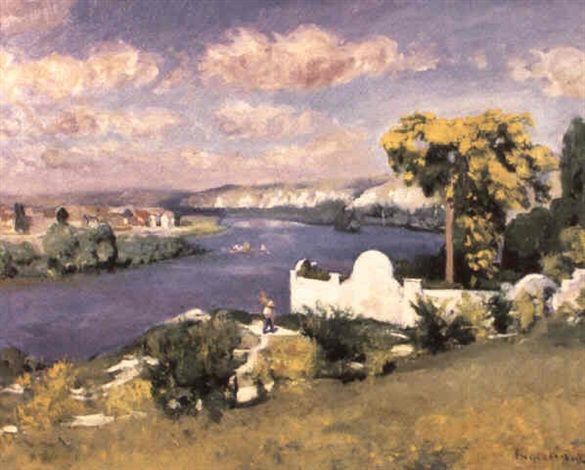Musée
Jacquemart-André
18 March - 25 July 2016
This
spring, the Musée Jacquemart-André is presenting an ensemble of some fifty or
so prestigious artworks—from both private collections and major American and
European museums—that retrace the history of Impressionism, from the
forefathers of the movement to the Great Masters.
The 19th century saw the
emergence of a new pictorial genre: ‘plein-air’ or outdoor landscape painting.
This pictorial revolution, born in England, would spread to the continent in
the 1820s and over the course of a century, Normandy would become the preferred
destination of many avant-garde painters. The region’s stunning and diverse
landscapes, coupled with the wealth of its architectural heritage, had much to
please artists.
Furthermore, the growing fashion for sea-bathing attracted many
wealthy individuals and families who could easily access Normandy by either
boat or stage-coach, and later by train. Its popularity was also increased due
to its enviable location—halfway between London and Paris, the two art capitals
of the period.
Following the end of the Napoleonic Wars, British landscape
artists such as Turner, Bonington, and Cotman travelled to Normandy, with their
boxes of watercolours, while the French—Géricault, Delacroix, Isabey—made their
way to London to discover the English school.
From these exchanges, a French
landscape school was born, with Corot and Huet at the helm. In their wake,
another generation of painters would in turn explore the region (Delacroix,
Riesener, Daubigny, Millet, Jongkind, Isabey, Troyon), inventing a new
aesthetic. This artistic revolution truly began to take form at the beginning
of the 1860s, the fruit of lively discussions and exchanges at the Saint-Siméon
Farm in Honfleur on Normandy’s Flower Coast, increasingly popular with the
crème de la crème of this new school of painting. These included Boudin, Monet
and Jongkind—an inseparable trio—but also their friends: Courbet, Daubigny,
Bazille, Whistler, and Cals...And of course, Baudelaire, who was the first to
celebrate in 1859, the ‘meteorological beauties’ of Boudin’s paintings.
Not far
away, in the hedgerows and woodlands of the Normandy countryside, Degas painted
his first horse races at Haras-du-Pin and Berthe Morisot took up landscape
painting, while at Cherbourg, Manet would revolutionize seascapes. For several
decades, Normandy would be the preferred outdoor or ‘plein-air’ studio of the
Impressionists. Monet, Degas, Renoir, Pissarro, Sisley, Boudin, Morisot, Caillebotte,
Gonzales, and Gauguin would all experiment with their art here in a constant
quest for originality and innovation.
The aim of this exhibition is to evoke the
decisive role played by Normandy in the emergence of the Impressionist
movement, through exchanges between French and British landscape painters, the
development of a school of nature and the encounters between artists at
Saint-Siméon. From a historical to a geographic approach, the exhibition then
shows how the Normandy landscape, especially the quality of its light, were
critical in the attraction that the region had on the Great Impressionist
Masters
For
a long time, the history of Impressionism has been understood as having a
relatively short chronology, beginning in 1863 with the Salon des Refusés and
ending in 1886 with the 8thExposition Impressioniste. This approach assigned a
crucial role to Paris and the Île-de-France region but very little to other
areas of France and to foreign influences.
Research carried out over the past
thirty or so years has led us to reconsider the history of the movement and to
situate it within a longer time frame which puts the origins or roots of
Impressionism at the beginning of the 1820s. This new approach also underlines
the influence of the English School in the birth of a French Landscape School
and assigns Normandy a decisive role in the emergence of the Impressionist
movement.
Several factors may explain why Normandy was the birthplace of
Impressionism
• its geographical location, half-way between London and Paris,
the two artistic epicentres of the time
(Courbet, L’Embouchure de la Seine also
known as Vue prise des hauteurs de Honfleur, Palais des Beaux-Arts, Lille).
•
the region’s rich architectural heritage at a time when artists played an
active role in its preservation and promotion
(Corot, Jumièges, Smith College
Museum of Art, Northampton) ;
in 1820 Isidore Taylor published his Voyages
pittoresques et romantiques dans l’ancienne France, with the first two volumes
devoted to Normandy. In 1825, Victor Hugo published an essay on the
preservation of French patrimonial monuments entitled Guerre aux démolisseurs.
•
the fashion for sea-bathing, imported from England, which became popular in
Dieppe circa 1820, before spreading along the Channel coastline.
• the beauty
and diversity of the region’s landscapes, as well as the subtlety and
versatility of the light, in an era when landscape painting became a genre in
its own right and when painters began to leave their studios to paint nature as
they saw it, outdoors and in natural light.
(Monet, La Charrette. Route sous la
neige à Honfleur avec la ferme Saint-Siméon, Musée d’Orsay, Paris).
• ease of
access by river and later by train. Railway lines between Paris and the
Normandy coast were amongst the first to be created, facilitating the growing
popularity of seaside resorts.

William Turner (1775-1851) Lillebonne, 1823
Watercolour, gouache, brown and black ink13,4 x 18,5 cm Oxford, The Ashmolean
Museum. Presented by John Ruskin, 1861© Ashmolean Museum, University of
Oxford
The
Open-Air Studio The Impressionists in Normandy
The
coastline was traditionally the preserve or domain of fishermen. This was where
they unloaded their cargo or mended their nets, or where their wives would wash
laundry or collect shellfish.
(Boudin, Marée basse à Trouville, pêcheurs de
crevettes, Association Peindre en Normandie, Caen).
With
the fashion for sea-bathing, the coastline was transformed into a beach, a
place now shared between the workers of the sea and summer holidaymakers at
seaside resorts.
(Monet, Sur les planches de Trouville, hôtel des Roches noires,
collection particulière).
On the one hand, there existed a working class that
was increasingly sidelined, and on the other hand, an aristocracy and upper
middle class who came to the Normandy coast to take advantage of the fresh air
and sea-bathing, with a social life akin to the capital’s. Hence the creation
of promenades (the famous wooden boardwalks in Trouville and Deauville); race
tracks
(Degas, Course de gentlemen. Avant le départ, Musée d’Orsay, Paris);
bandstands where concerts were held; casinos for betting, and attending
operettas or plays. Soon tennis clubs based on the English model would open up
all along the coast. All of these venues were places of conviviality and a
means of social segregation.
Under
the Second Empire (1852 – 1870), a period of industrialization during which
many families amassed large fortunes, the concept of summer holidays became
hugely popular. New seaside resorts sprung up all along the Flower Coast (Côte
Fleurie) between Deauville and Cabourg. The emergence of a ‘lifestyle of
leisure’ chronicled by the painters of the time was a godsend to many artists
who had previously struggled to sell their ‘seascapes’ and who could now
command high prices for their ‘beach scenes’. This genre, invented by Eugène
Boudin in 1862 would be imitated by all of his Impressionist friends
(Boudin,
Crinolines à Trouville, collection particulière).
Claude Monet(1840-1926) Sur
les planches de Trouville, hôtel des Roches noires, détail 1870 50 x 70 cm, oil
on canvas Collection particulière © Christie’s Images / Bridgeman Images
Rooms
2 & 3
Beaches,
leisure and society life
The
coastline of the English Channel, with its tumultuous tides and impressive
storms, had long inspired a romantic vision of the sea, as skilfully depicted
in the work of both Eugène Isabey and William Turner. However as seaside
resorts grew, painters devoted themselves to a new vision of their marine
environment. They became less interested in the sea itself and more in its
natural and human environment
(Pissarro, Avant-port de Dieppe, après-midi,
soleil, Château-Musée de Dieppe).
With its ports teeming with boats, stretching
from Tréport to the bay of Mont-Saint-Michel, and its sheer cliffs, where the
whiteness of the chalk contrasted with the verdant grass covering, the Channel
coastline offered an infinite variety of subjects and motifs to be painted

Paul
Gauguin (1848-1903) Le Port de Dieppe, around 1885 60,2 x 72,3 cm, oil on canvas
Manchester, Royaume-Uni, Manchester City Galleries© Manchester Art Gallery, UK
/ Bridgeman Images
(Gauguin,Le Port de Dieppe, Manchester City Galleries).
Dieppe, which was the
first seaside resort to be created in the 1820s, attracted many of the leading
figures of this new style of painting (Monet, Renoir, Degas, Boudin, Pissarro
and Gauguin) following the War of 1870, as well as artists Blanche, Gervex and
Helleu, referred to as ‘society painters’ (one should of course pay little heed
to such artificial classifications). It also attracted other unclassifiable
artists like Eva Gonzalès, Manet’s only student and last but not least, a large
number of Anglo-Saxon artists
room
4
From
ports to cliffs – Dieppe
For
artists in search of subject matter to paint, Normandy’s Alabaster Coast
provided plenty of examples of stunning natural architecture: immense
panoramas, a rugged coastline of estuaries and valleys, and huge white chalk
cliffs, eroded by the sea and the wind. Maupassant would compare the natural
cliff arches of Manneport d’Étretat to an ‘enormous cave through which a ship
with all its sails unfurled could pass’ and the Porte d’Amont to ‘the huge
figure of an elephant’s trunk plunged into the waves’.But above all what
Courbet, Monet, Renoir and Berthe Morisot sought in this section of the coast
were the incredible chromatic variations of the sea and the sky, connected to
the ebb and flow of the tides, the passing wind and the clouds, and the sea
spray. These continuous atmospheric changes were for them a powerful stimulus
to work quickly, without getting too bogged down in detail, so as to be able to
render the smallest nuances in the light

(Monet, Falaises à Varengeville also
known as Petit-Ailly, Varengeville, plein soleil, Musée d’art moderne André
Malraux, Le Havre).
The central place given to the treatment of the light would
bring Courbet, in 1869, to experiment with the process of making series of
paintings, depicting for example the cliffs at Étretat in different light
(Courbet, La Falaise d’Étretat, Van der Heydt-Museum, Wuppertal).
In the 1880s
and 1890s, Monet would also use this process, painting numerous depictions of
cliffs, from those at Petites-Dalles in Fécamp to ones at Étretat,
Varengeville, Porville and Dieppe

Claude
Monet Etretat, la porte d’Aval, bateaux de pêche sortant du port, around1885 60
x 80 cm, oil on canvas Dijon, Musée des Beaux-Arts© Musée des beaux-arts de
Dijon Photo François Jay
room
5
From
ports to cliffs - The Alabaster Coast
Towards
the middle of the century a new means of transport appeared: the train, which
would completely revolutionize travel. Railway lines between Paris and the
Normandy coast were amongst the first to be created. The Paris-Rouen line was
opened in 1843, extended to Le Havre in 1847, to Dieppe the following year, and
in 1856 to Fécamp. In the 1860s, trains stopped at Deauville-Trouville and all
the other seaside resorts along the Flower Coast. In their advertising
campaigns, railroad companies highlighted the fact that travellers could reach
the coast in two to three hours. There were even special trains running for
certain events, such as the naval battles of the American Civil War fought off
the coast of Cherbourg, attended by Manet in 1864.The train was not only used
by Parisian artists (Morisot, Degas, Manet, Caillebotte, etc.) seeking to leave
the capital and to soak up the fresh sea air at the coast in their quest for
new subject matter to paint. It was also used by painters from Normandy
(Boudin, Monet, Dubourg, Lépine, Lebourg, etc.) who travelled to Paris to
exhibit their work at the Salon, visiting exhibitions, meeting with fellow
artists, as well as art dealers and collectors during their stay.

Berthe Morisot
(1841-1895) La Plage des Petites-Dalles, around 1873 24,1 x 50,2 cm, oil on
canvas Richmond, Virginie, Virginia Museum of Fine Arts, Collection of Mr and
Mrs Paul Mellon © Virginia Museum of Fine Arts/Katherine Wetzel
room
6
The
railroad
Claude
Monet(1840-1926) Barques de pêche, Honfleur, around 1866 46 x 55 cm, oil on
canvas Collection particulière© Collection particulière
Like
the Alabaster Coast, the ports and coastline stretching from Le Havre to
Cherbourg would equally captivate Boudin, Monet and Pissarro, as well as Berthe
Morisot, Degas, Signac, Seurat and many other landscape artists. Amongst them,
was a practically unknown painter: Charles Pécrus, converted by his friend
Boudin to the art of landscape painting and whose very lively port scenes would
owe a lot to Boudin’s influence (Pécrus, Le Port de Honfleur, Association
Peindre en Normandie, Caen).Towards the end of his life, Boudin would adopt an
even brighter palette and an even bolder and freer brushstroke. Pursuing his
passionate quest for light, he would focus on the shimmering reflections of the
water, the vibrations of the air, and the clouds as they raced across an
enormous sky (Entrée du port du Havre par grand vent, Collection particulière,
Courtesy Galerie de la Présidence, Paris).
This sensitive, delicate art is
completely removed from the vigorous representations—heralding the
Expressionist and Fauvist movements—which Monet, at the beginning of his
career, would produce of fishing boats moored in the port of Honfleur (Barques
de pêche, collection particulière, et Bateaux de pêche, Muzeul National de Arta
al României, Bucarest).
To capture the comings and goings of the boats and the
strollers, Pissarro and Berthe Morisot preferred to make use of slightly
plunging perspectives, from an elevated viewing point. Berthe was especially
interested in the effects of perspective, which she skilfully mastered
(L’Entrée du port de Cherbourg, Yale University Art Gallery), while Pissarro
attempted to capture the passage of time and atmospheric variations, delivering
a superb series of port views of Le Havre which form part of his artistic
legacy (L’Anse des Pilotes et le briselames est, Le Havre, après-midi, temps
ensoleillé, Musée d’art moderne André Malraux, Le Havre).
room
7
From
ports to cliffs - From Le Havre to Cherbourg
If
throughout the course of the 19thcentury, Rouen attracted so many landscape
painters from Turner, Boninton and Corot to Monet and Pissarro, it was because
of the town’s remarkable architectural heritage. Rouen was celebrated by Victor
Hugo as the ‘city of a hundred bell towers’ and was immortalized by Monet (La
Rue de l’Épicerie à Rouen, Collection particulière, courtesy of the Fondation
Pierre Gianadda, Martigny). The destination was made even more attractive due
to its topography, which Flaubert compared to an amphitheatre. Nestled between
the river and the surrounding hills, the town not only offered ‘the most
splendid landscape that a painter could ever dream of’ (Pissarro) but above all,
the effects of fog and rain and the constant atmospheric variations proved to
be a source of great pleasure to all those in search of the ephemeral. The
liveliness of the port and its industrial landscape, where the tall factory
chimneys on the left bank echoed the bell towers on the right bank, would draw
Pissarro to make this enthusiastic comparison: ‘It’s as beautiful as Venice’
(Le Pont Boieldieu, Rouen, effet de pluie, Staatliche Kunsthalle, Karlsruhe,
room 7). Many of the Impressionist masters (Monet, Pissarro, Sisley, Gauguin)
would stay in Rouen. This, coupled with the presence of several important
collectors (François Depeaux, Léon Monet, Eugène Murer) would favour the birth
of a Rouen School to cite the expression of art critic, Arsène Alexandre. Monet
in Giverny Claude Monet lived for 43 years in his house in Giverny from 1883 to
1926. Passionate about gardening, he designed his gardens as veritable
paintings. In 1893, he put in a pond which he had covered with lily pads and
created a Japanese-style garden ‘for the pleasure of the eye but also with the
intention of providing subject matter for painting’. Until his death, his
garden proved to be his most fertile source of inspiration. Indeed, he once
said : ‘My most beautiful masterpiece is my garden’.
Monet began painting
waterlilies in 1895 and his Japanese bridge would be the object of some fifty
canvases. Taking out the horizon and the sky, he narrowed his focus on the
bridge, the water and the reflections. From 1918 onwards, the pictorial elements
or details would give way to an explosion of colours, with the density of the
brushstrokes bordering on abstraction. The water and the sky seem to merge and
under these fireworks of colour, the bridge appears little by little, providing
a landmark or a point of reference to the composition.
As Daniel Wildenstein,
author of the catalogue raisonné of the artist, would say, the exceptional
series of the Pont japonaisrepresents the culmination of Monet’s oeuvre where
the vibration of the colour is enough to evoke a world of sensation and
powerful emotion
Room
8
Along
the Seine, from Rouen to Giverny
If
throughout the course of the 19th century, Rouen attracted so many
landscape painters from Turner, Boninton and Corot to Monet and Pissarro, it
was because of the town’s remarkable architectural heritage. Rouen was
celebrated by Victor Hugo as the ‘city of a hundred bell towers’ and was
immortalized by Monet (La Rue de l’Épicerie à Rouen, Collection particulière,
courtesy of the Fondation Pierre Gianadda, Martigny). The destination was made
even more attractive due to its topography, which Flaubert compared to an
amphitheatre. Nestled between the river and the surrounding hills, the town not
only offered ‘the most splendid landscape that a painter could ever dream of’
(Pissarro) but above all, the effects of fog and rain and the constant
atmospheric variations proved to be a source of great pleasure to all those in
search of the ephemeral. The liveliness of the port and its industrial
landscape, where the tall factory chimneys on the left bank echoed the bell
towers on the right bank, would draw Pissarro to make this enthusiastic
comparison: ‘It’s as beautiful as Venice’ (Le Pont Boieldieu, Rouen, effet de
pluie, Staatliche Kunsthalle, Karlsruhe, room 7). Many of the Impressionist
masters (Monet, Pissarro, Sisley, Gauguin) would stay in Rouen. This, coupled with
the presence of several important collectors (François Depeaux, Léon Monet,
Eugène Murer) would favour the birth of a Rouen School to cite the expression
of art critic, Arsène Alexandre.
Monet in Giverny
Claude Monet lived for 43
years in his house in Giverny from 1883 to 1926. Passionate about gardening, he
designed his gardens as veritable paintings. In 1893, he put in a pond that he
had covered with lily pads and created a Japanese-style garden ‘for the
pleasure of the eye but also with the intention of providing subject matter for
painting’. Until his death, his garden proved to be his most fertile source of
inspiration. Indeed, he once said: ‘My most beautiful masterpiece is my
garden’. Monet began painting waterlilies in 1895 and his Japanese bridge would
be the object of some fifty canvases. Taking out the horizon and the sky, he
narrowed his focus on the bridge, the water and the reflections. From 1918
onwards, the pictorial elements or details would give way to an explosion of
colours, with the density of the brushstrokes bordering on abstraction. The
water and the sky seem to merge and under these fireworks of colour, the bridge
appears little by little, providing a landmark or a point of reference to the
composition.
As
Daniel Wildenstein, author of the catalogue raisonné of the artist, would say,
the exceptional series of the Pont japonais represents the culmination of
Monet’s oeuvre where the vibration of the colour is enough to evoke a world of
sensation and powerful emotion (Pont
japonais, Collection Larock-Granoff, Paris).
Louis Anquetin (1861-1932) La Seine
près de Rouen, 1892 79 x 69 cm, oil on canvas Collection particulière©
Collection particulière / Tom Haartsen
Camille Pissarro (1830-1903) Le Pont
Boieldieu, Rouen, effet de pluie,1896 73 x 92 cm, oil on canvasKarlsruhe,
Staatliche Kunsthalle© BPK, Berlin, Dist. RMN-Grand Palais / Image
Kunstsammlung Nordrhein-Westfalen
COMPLETE CREDITS
RENOIR Pierre-Auguste (1841-1919) La Côte près de Dieppe - 1879 - Oil on canvas
- 49,5 x 60,6 cm Montclair, New Jersey, Kasser Mochary Foundation © Photo Tim
Fuller © Kasser Mochary Foundation, Montclair, NJ
CAILLEBOTTE Gustave (1848-1894) Régates en mer à Trouville - 1884 - 60,3 x 73
cm - Oil on canvas - Toledo, Ohio. Lent by the Toledo Museum of Art. Gift of The Wildenstein
Foundation © Photograph Incorporated, Toledo
MONET Claude (1840-1926) Etretat, la porte d’Aval, bateaux de pêche
sortant du port - around 1885 - Oil on
canvas - 60 x 80 cm - Dijon, Musée des
Beaux-Arts © Musée des beaux-arts de Dijon. Photo François Jay
RENOIR Pierre-Auguste (1841-1919) La Cueillette des moules - 1879 - Oil on
canvas - 54,2 x 65,4 cm - Washington D.C., National Gallery of Art. Gift of Margaret Seligman Lewisohn in
memory of her husband, Sam A. Lewisohn © Courtesy National Gallery of Art,
Washington
GAUGUIN Paul (1848-1903) Le Port de Dieppe - around 1885 -
Oil on canvas - 60,2 x 72,3 cm - Manchester, Royaume-Uni, Manchester City Galleries © Manchester Art Gallery, UK /
Bridgeman Images
SIGNAC Paul (1863-1935) Port-en-Bessin. Le Catel - around 1884 - Oil
on canvas - 45 x 65 - Collection particulière © Collection particulière
CALS
Félix (1810-1880) Honfleur, Saint-Siméon -1879 - Oil on canvas -
35 x 54 cm - Caen, Association Peindre en Normandie © Association Peindre en Normandie
BOUDIN
Eugène-Louis (1824-1898) Scène de plage à Trouville - 1869 - 28 x 40 cm - Oil on panel -
Collection particulière. Courtesy Galerie de la Présidence, Paris © Galerie de la
Présidence, Paris
MONET Claude (1840-1926) Camille sur la plage à Trouville - 1870 - Oil on canvas - 38,1 x 46,4 cm - New
Haven, Yale University Art Gallery,
Collection of Mr. and Mrs John Hay Whitney, B.A. 1926, Hon. 1956 © Photo
courtesy of Yale University Art Gallery
PISSARRO Camille (1830-1903) Avant-port de Dieppe, après-midi, soleil -
1902 - Oil on canvas - 53,5 x 65 cm Dieppe, Château-Musée © Ville de Dieppe -
B. Legros
MONET Claude (1840-1926) L’Église de Varengeville à
contre-jour - 1882 - Oil on canvas - 65 x 81,3 cm - Birmingham, The Henry Barber Trust, The Barber Institute of Fine
Arts, University of Birmingham © The Barber Institute of Fine Arts, University
of Birmingham
BONINGTON Richard
Parkes (1802-1828) Plage de sable en Normandie - around 1825-1826 - Oil on
canvas - 38,7 × 54 cm - Trustees of the
Cecil Higgins Art Gallery Bedford (The Higgins Bedford) © Trustees of the Cecil
Higgins Art Gallery, Bedford
MONET Claude (1840-1926) Falaises à Varengeville also known as Petit-Ailly, Varengeville, plein soleil - 1897 - Oil on canvas - 64 x 91,5 cm - Le Havre, Musée d’art moderne André
Malraux © MuMa Le Havre / Charles Maslard 2016
BOUDIN Eugène-Louis
(1824-1898) Entrée du port du Havre par
grand vent - 1889 - Oil on canvas - 46 x 55 cm - Collection particulière. Courtesy Galerie de la Présidence, Paris ©
Galerie de la Présidence
COURBET
Gustave ( 1819-1877) La Plage à
Trouville - around 1865 - Oil on canvas - 34 x 41 cm - Caen, Association
Peindre en Normandie © Association
Peindre en Normandie
MONET Claude (1840-1926) La Rue de l’Épicerie à Rouen - around 1892 - Oil on canvas - 93 x 53 cm -
Collection particulière. Courtesy Fondation
Pierre Gianadda, Martigny (Suisse) © Claude Mercier photographe
ANQUETIN Louis (1861-1932) La Seine près de Rouen - 1892 - Oil on canvas
- 79 x 69 cm - Collection particulière © Collection particulière / Tom Haartsen
MORISOT Berthe (1841-1895) La Plage des Petites-Dalles - around 1873 - Oil on canvas - 24,1 x 50,2 cm Richmond,
Virginie, Virginia Museum of Fine Arts, Collection


















